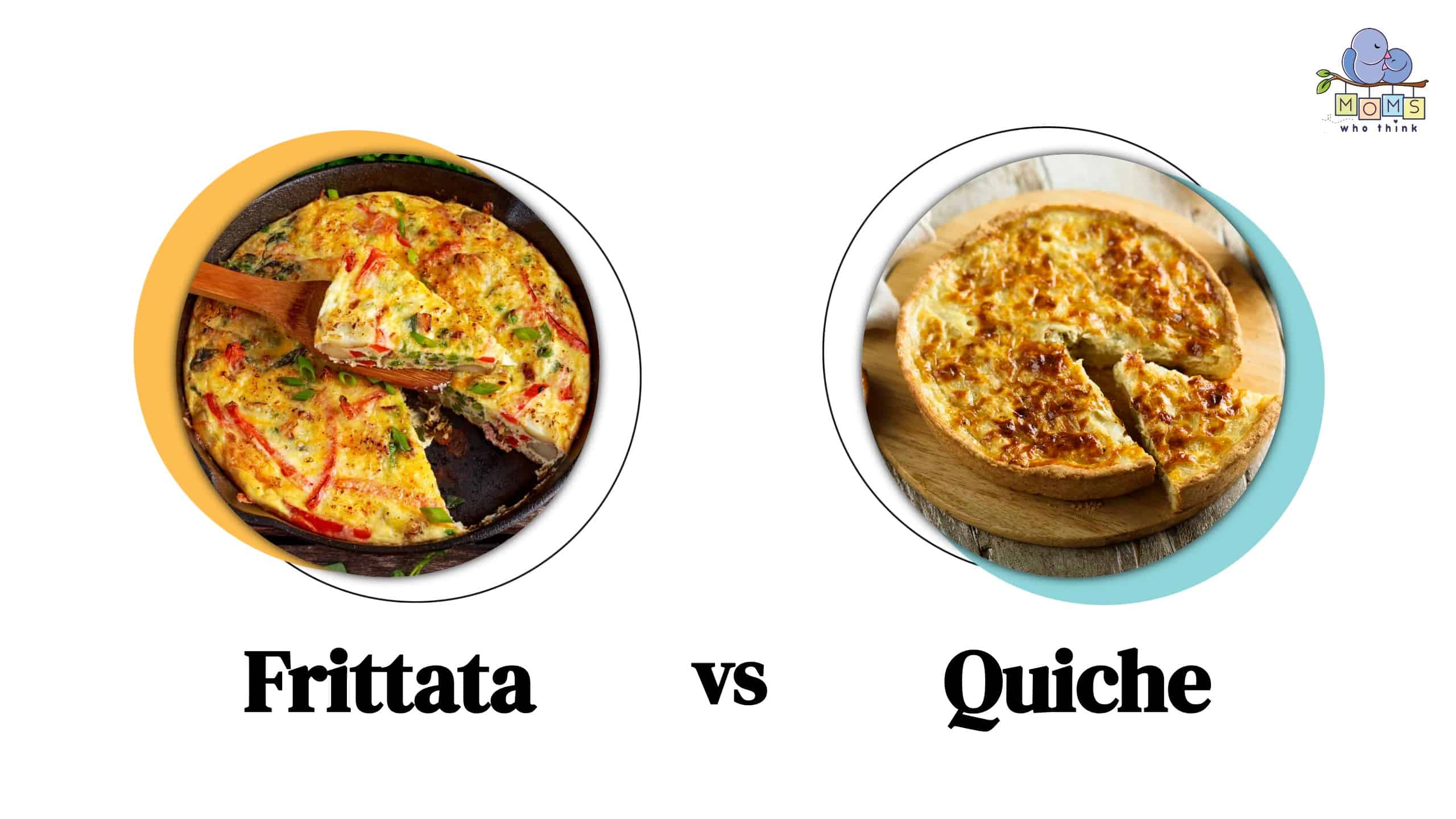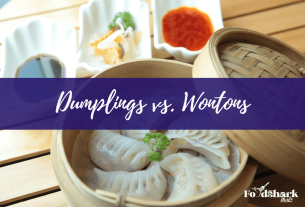Have you ever found yourself standing in front of a buffet table, torn between the choices of frittata or quiche?
Well, look no further because we’re about to embark on a delicious journey through the world of these two delectable dishes.
Picture a perfect harmony between an omelet and a crustless quiche, resulting in a culinary marvel known as the frittata.
Join us as we unravel the mysteries and savor the flavors of these mouthwatering creations.
frittata vs quiche
The main difference between a frittata and a quiche is that a frittata is cooked without a crust, while a quiche has a crust made from pastry.
Frittatas are made by mixing eggs with dairy, vegetables, meats, and cheeses, then cooking them slowly in a skillet and finishing in the oven.
They are similar to omelets, but with all ingredients mixed together before cooking.
Frittatas are quick to make and are often served at brunch buffets.
Key Points:
- Frittatas are cooked without a crust, while quiches have a crust made from pastry.
- Frittatas are made by mixing eggs with dairy, vegetables, meats, and cheeses.
- Frittatas are cooked slowly in a skillet and finished in the oven.
- Frittatas are similar to omelets, but with all ingredients mixed together before cooking.
- Frittatas are quick to make.
- Frittatas are often served at brunch buffets.
frittata vs quiche – Watch Video
💡
Pro Tips:
1. The word Frittata comes from the Italian verb “friggere,” which means “to fry,” while Quiche originates from the German word “kuchen,” meaning “cake.”
2. Frittatas are traditionally cooked in a skillet on the stovetop and finished under the broiler, while Quiches are baked in a pastry crust.
3. Frittatas are known for their versatility, as they can be served hot or cold, making them a popular option for picnics and brunches. On the other hand, Quiches are typically enjoyed warm, straight out of the oven.
4. Frittatas are often made with a combination of eggs, cheese, and various fillings such as vegetables, meats, or herbs. Quiches, on the contrary, commonly feature a custard-like filling made from eggs, cream, cheese, and a range of ingredients like bacon, vegetables, or seafood.
5. While Frittatas are common in Italian cuisine, Quiches are more closely associated with French and German culinary traditions. However, both dishes have gained worldwide popularity and can be found in various countries’ cuisines, often with unique regional twists.
Introduction To Frittata Vs Quiche
When it comes to egg-based delights, frittatas and quiches are two popular options that often find their way onto brunch menus and kitchen tables. Both dishes offer a perfect balance of flavors and textures, but they have distinct characteristics that set them apart. In this article, we will explore the secrets of these delightful dishes and discover the differences and similarities between frittatas and quiches. Whether you are a culinary enthusiast or simply a lover of good food, this article will provide insight into the world of frittatas and quiches and why frittatas are a delicious alternative to quiches.
Defining A Frittata
Originating from Italy, frittatas are a popular dish that is often described as a cross between an omelet and a crustless quiche. The word “frittata” literally translates to “fried” in Italian, which reflects the traditional cooking method of slowly cooking the mixture in a skillet before finishing it off in the oven. Unlike omelets, which are usually folded over, frittatas contain all the ingredients mixed together before being poured into the skillet. This mixing of ingredients sets frittatas apart from both omelets and quiches and gives them a unique texture and flavor profile.
Traditional Frittata Ingredients
The beauty of frittatas lies in their versatility, as they can be made with a wide array of ingredients. However, traditional frittatas often include eggs beaten with dairy, such as heavy cream or half and half, which results in a rich and creamy texture. Along with the eggs and dairy, frittatas typically incorporate a variety of ingredients like vegetables, meats, and cheeses. This allows for endless combinations and the opportunity to showcase seasonal produce and flavors. The choice of ingredients is entirely up to the cook’s preference, making frittatas a customizable dish that can cater to different tastes and dietary restrictions.
- Frittatas can be made with a wide array of ingredients.
- Traditional frittatas use eggs beaten with dairy for a creamy texture.
- Frittatas incorporate vegetables, meats, and cheeses.
- Frittatas allow for endless combinations and seasonal flavors.
- The choice of ingredients in frittatas is customizable.
The Cooking Process Of A Frittata
Cooking a frittata involves a two-step process that ensures the perfect texture and flavor. The first step is to cook the mixture slowly in a skillet, without flipping it. This allows the frittata to set and cook evenly without losing its shape. Once the bottom and sides of the frittata are cooked, it is transferred to the oven to finish cooking and brown the top. This combination of stovetop and oven cooking results in a perfectly cooked frittata with a golden crust on top and a moist and fluffy interior.
Similarities To Omelets
Frittatas and omelets are similar in terms of cooking method and ingredients. They are both cooked in a skillet and often include vegetables, meats, and cheeses. However, the key difference lies in the preparation. Frittatas have all the ingredients mixed together before cooking, while omelets are made by folding the beaten egg mixture over the fillings. This distinction gives each dish its unique texture and presentation.
Differences Between Frittatas And Omelets
Although frittatas and omelets share similarities, they have distinctive characteristics that set them apart. Frittatas have a more substantial and denser texture compared to omelets, which tend to be lighter and fluffier. The cooking process of a frittata also differs from that of an omelet, with frittatas requiring an oven finish to brown the top, while omelets are cooked solely on the stovetop. Additionally, frittatas are often served in slices, while omelets are typically folded in half and served as a single piece.
Benefits Of Making A Frittata
One of the key benefits of making a frittata is its versatility and flexibility. Frittatas can be made with various ingredients, offering an excellent opportunity to use up leftover vegetables, meats, and cheeses, thereby reducing food waste. Additionally, frittatas are a quick and easy dish to prepare, making them an ideal option for busy mornings or when hosting brunches. They are also a great choice for those following a low-carb or gluten-free diet, as frittatas are typically crustless.
The Versatility Of Frittatas As A Brunch Option
Frittatas are a fantastic option for brunches due to their versatility and ability to cater to different tastes and dietary restrictions. Whether you prefer a vegetarian frittata filled with seasonal vegetables or a meat lover’s delight with bacon and sausage, the possibilities are endless. Frittatas can also be prepared in advance and served at room temperature or reheated, making them hassle-free for hosts and guests alike. The incorporation of various ingredients and flavors ensures that there is always a frittata that appeals to everyone’s palate.
The Popularity Of Frittatas At Brunch Buffets
Brunch buffets are incomplete without the presence of a delicious frittata. Frittatas offer a quick and easy option for hosts, as they can be prepared in advance and served at room temperature. At buffets, frittatas also shine because they are visually appealing with their golden brown tops and vibrant fillings. Furthermore, frittatas can be sliced into individual servings, making them convenient for guests to enjoy without the need for additional utensils. The popularity of frittatas at brunch buffets is a testament to their appeal and ability to please a crowd.
Conclusion: Frittatas Offer A Quick And Delicious Alternative To Quiche
Frittatas are a delightful Italian dish that combines the qualities of both omelets and quiches. With their rich and creamy texture, customizable ingredients, and quick cooking process, frittatas offer a delicious alternative to quiches. Whether you’re hosting a brunch buffet or looking for a simple and satisfying meal, frittatas are a versatile option that will never disappoint. So, why not give frittatas a try and indulge in the flavorful world of egg-based delights?
💡
You may need to know these questions about frittata vs quiche
Is a frittata just a crustless quiche?
While both frittatas and quiches share similarities, a frittata is not simply a crustless quiche. The absence of a crust is certainly one distinction between the two. In addition, the base ingredients differ significantly. Quiches typically incorporate an egg custard made with cream or milk, while frittatas may sometimes feature egg whites. These variations in ingredients and preparation contribute to subtle differences in taste and texture, making a frittata its own unique dish.
Is frittata healthier than quiche?
Yes, frittata is generally considered to be healthier than quiche. Unlike quiche, which typically includes a buttery crust, frittata does not contain any crust, reducing the overall calorie and fat content. Additionally, frittatas offer the flexibility to incorporate an abundance of vegetables and adjust the amount of oil used, allowing for a nutritious and personalized meal. This makes frittata a healthier alternative, akin to the benefits of an omelet, while still providing a flavorful and satisfying dish.
What’s the difference between a frittata and an omelette and a quiche?
While quiches, omelets, and frittatas all involve eggs as their main ingredient, they differ in their cooking methods and presentation. Quiches are baked in the oven, resulting in a savory, flaky crust encasing a creamy, custard-like filling. On the other hand, omelets are gently cooked over stovetop heat, folded over, and typically have a softer center. In contrast, frittatas are cooked on the stovetop over low heat, with the option of flipping the top or finishing it off in the oven. This results in a more firm and fully cooked dish that can be sliced into wedges for serving.
What is the English name for frittata?
In English, the equivalent term for frittata is “open-face omelette.” This name captures the essence of the dish, which is similar to an omelette but prepared in a slightly different manner. The term “frittata” was initially used interchangeably with omelette outside of Italy, emphasizing the similarities between the two. However, as Delia Smith explains, the frittata has evolved into its own variation and earned its distinct title of “Italy’s version of an open-face omelette.”
Reference source
https://www.kitchenaid.com/pinch-of-help/major-appliances/frittata-vs-quiche.html
https://www.foodnetwork.com/how-to/packages/food-network-essentials/frittata-vs-quiche
https://www.webmd.com/diet/ss/slideshow-best-worst-brunch
https://www.allrecipes.com/article/difference-between-frittata-quiche-strata/



